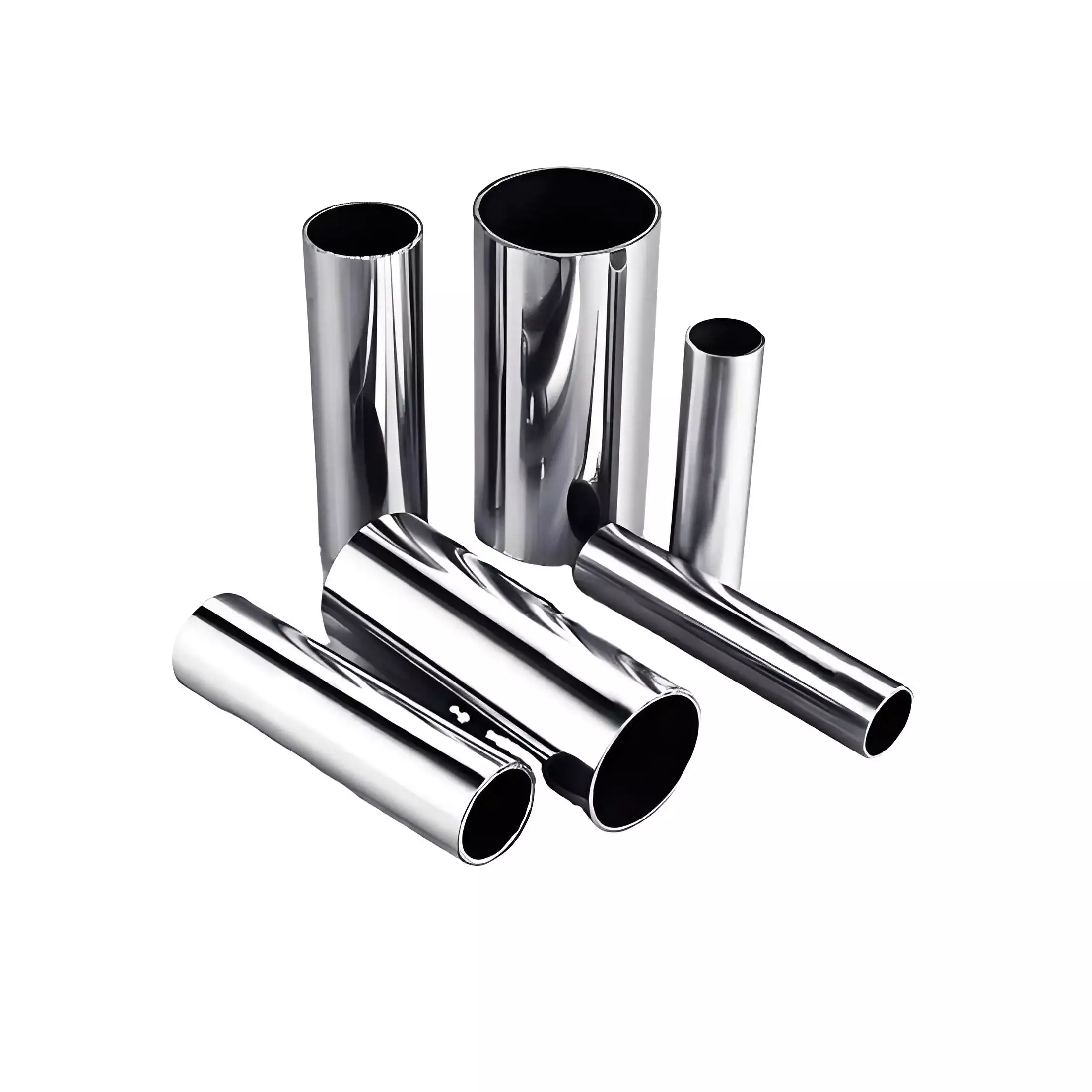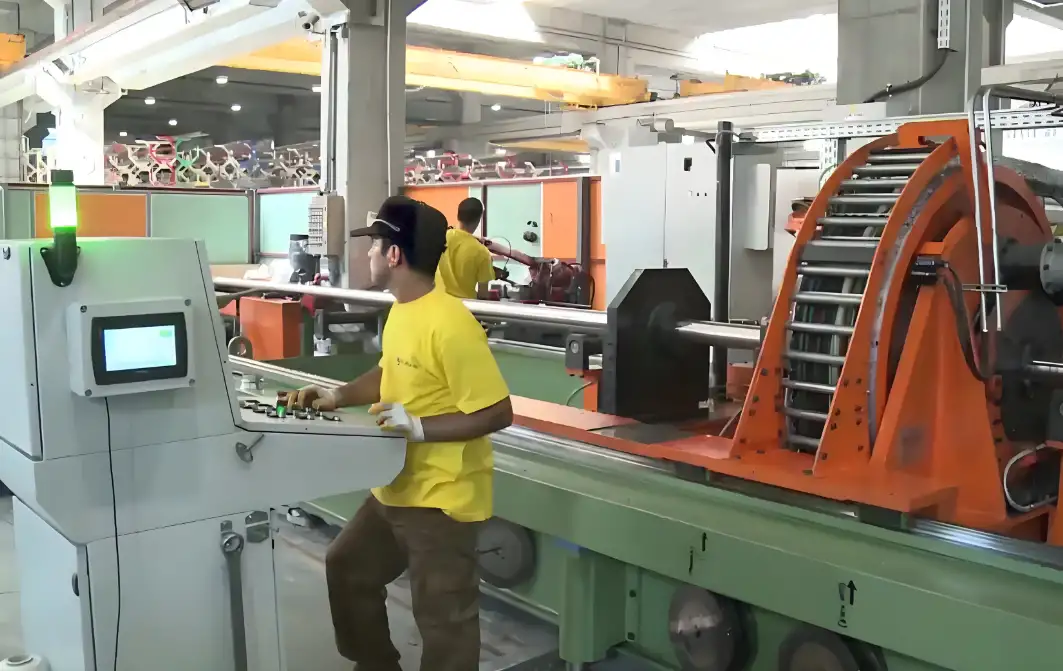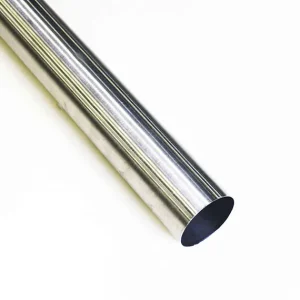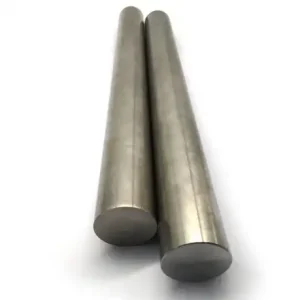Hastelloy Alloy C-22 ist die fortschrittlichste Entwicklung in der Nickel-Chrom-Molybdän-Wolfram-Superlegierungstechnologie und bietet eine hervorragende Beständigkeit gegen lokale Korrosion und Spannungsrisskorrosion in den anspruchsvollsten industriellen Umgebungen. Wir bei MWalloys haben miterlebt, wie dieser außergewöhnliche Werkstoff Anwendungen in der nuklearen Abfallverarbeitung, in Entsalzungsanlagen und in der fortschrittlichen chemischen Fertigung revolutioniert hat, wo traditionelle Superlegierungen an ihre Leistungsgrenzen stoßen. Mit seiner optimierten Zusammensetzung aus 22% Chrom, 13% Molybdän und 3% Wolfram in einer Nickelmatrix bietet C-22 eine noch nie dagewesene Beständigkeit gegen Lochfraß, Spaltkorrosion und allgemeine Angriffe in chloridreichen Umgebungen bei erhöhten Temperaturen. Die außergewöhnliche thermische Stabilität und die vielseitige Verarbeitbarkeit der Legierung machen sie zum bevorzugten Werkstoff für kritische Infrastrukturprojekte wie die Lagerung hochradioaktiver Abfälle, Meerwasserentsalzungsanlagen und pharmazeutische Produktionsanlagen, bei denen ein Materialversagen katastrophale Folgen für die Sicherheit und die Wirtschaftlichkeit hat.
Was ist die Hastelloy-Legierung C-22?
Hastelloy Alloy C-22 ist der neueste Fortschritt in der Nickelbasis-Superlegierungstechnologie, die speziell entwickelt wurde, um die Grenzen früherer korrosionsbeständiger Legierungen in hochaggressiven Umgebungen zu überwinden. Wir klassifizieren diesen Werkstoff als vielseitige, mischkristallverfestigte Superlegierung, die außergewöhnliche Korrosionsbeständigkeit mit hervorragenden mechanischen Eigenschaften in extremen Temperaturbereichen verbindet.
Die Entwicklung der Legierung ergab sich aus den strengen Anforderungen der Nuklearindustrie an Werkstoffe, die in der Lage sind, hochradioaktiven Umgebungen und hohen Temperaturen standzuhalten und gleichzeitig die strukturelle Integrität über Jahrzehnte hinweg zu erhalten. Herkömmliche Werkstoffe, einschließlich früherer Hastelloy-Sorten, zeigten unter diesen extremen Bedingungen ihre Grenzen, was die Entwicklung der modernen Zusammensetzung von C-22 erforderlich machte.
Das metallurgische Gefüge von C-22 zeichnet sich durch eine stabile austenitische Matrix aus, die bei Temperaturschwankungen von kryogenen Bedingungen bis zu 1000 °C konstant bleibt. Diese mikrostrukturelle Stabilität verhindert die Bildung schädlicher sekundärer Phasen, die entweder die mechanischen Eigenschaften oder die Korrosionsbeständigkeit während längerer Betriebszeiten beeinträchtigen könnten.
Der niedrige Kohlenstoffgehalt der Legierung in Verbindung mit einer sorgfältigen Kontrolle der Verunreinigungselemente minimiert die Gefahr einer Sensibilisierung beim Schweißen und bei hohen Temperaturen. Diese Konstruktionsphilosophie stellt sicher, dass C-22 eine gleichmäßige Korrosionsbeständigkeit in komplexen Konstruktionen beibehält, einschließlich wärmebeeinflusster Zonen, in denen andere Werkstoffe Schwachstellen entwickeln könnten.
Wie ist die chemische Zusammensetzung der Hastelloy-Legierung C-22?
Die chemische Zusammensetzung von Hastelloy Alloy C-22 ist ein sorgfältig optimiertes Gleichgewicht von Elementen, das darauf ausgelegt ist, die Korrosionsbeständigkeit zu maximieren und gleichzeitig hervorragende mechanische Eigenschaften und Verarbeitbarkeit zu erhalten. Das Verständnis dieser elementaren Beiträge gibt Aufschluss über die außergewöhnlichen Leistungsmerkmale der Legierung.
| Element | Gewichtsprozent (%) | Primäre Funktion |
|---|---|---|
| Nickel (Ni) | 50.0 - 59.0 | Grundmetallmatrix für Stabilität |
| Chrom (Cr) | 20.0 - 22.5 | Passivierung und Oxidationsbeständigkeit |
| Molybdän (Mo) | 12.5 - 14.5 | Beständigkeit gegen Lochfraß und Spaltkorrosion |
| Wolfram (W) | 2.5 - 3.5 | Verbesserte örtliche Korrosionsbeständigkeit |
| Eisen (Fe) | 2.0 - 6.0 | Strukturelle Stabilität und Kostenoptimierung |
| Kobalt (Co) | 2,5 max | Steigerung der Stärke |
| Kohlenstoff (C) | 0,015 max | Minimiert, um Karbidausscheidungen zu verhindern |
| Mangan (Mn) | 0,50 max | Desoxidations- und Verarbeitungshilfsmittel |
| Silizium (Si) | 0,08 max | Desoxidationsmittel, kontrolliert auf Stabilität |
| Phosphor (P) | 0,02 max | Kontrolliert, um Versprödung zu verhindern |
| Schwefel (S) | 0,02 max | Minimiert für verbesserte Duktilität |
| Vanadium (V) | 0,35 max | Verfeinerung der Kornstruktur |
Das synergistische Zusammenspiel von Chrom, Molybdän und Wolfram verleiht C-22 eine außergewöhnliche Beständigkeit gegen lokale Angriffsformen, einschließlich Lochfraß und Spaltkorrosion in chloridhaltigen Umgebungen. Wir betonen, dass der höhere Chromgehalt im Vergleich zu C-276 die Passivierungseigenschaften verbessert, während die Molybdän-Wolfram-Kombination eine hervorragende Leistung unter reduzierenden Bedingungen bietet.
Der extrem niedrige Kohlenstoff- und Schwefelgehalt unterscheidet C-22 von herkömmlichen nichtrostenden Stählen und sogar von früheren Superlegierungen und verhindert die Bildung von Einschlüssen und Ausscheidungen, die als Ausgangspunkt für Korrosionsangriffe dienen könnten. Diese Reinheit der Zusammensetzung gewährleistet eine gleichbleibende Leistung während der gesamten Lebensdauer des Materials.
Was sind die mechanischen Eigenschaften von Hastelloy Alloy C-22?
Die mechanischen Eigenschaften von Hastelloy Alloy C-22 weisen über einen weiten Temperaturbereich hervorragende Leistungsmerkmale auf, die einen zuverlässigen Betrieb von kryogenen Anwendungen bis hin zu Hochtemperatur-Einsatzbedingungen ermöglichen. Diese Eigenschaften spiegeln das ausgeklügelte metallurgische Design und die optimierte Verarbeitung der Legierung wider.
| Eigentum | Raumtemperatur | 538°C | 700°C | Test Standard |
|---|---|---|---|---|
| Zugfestigkeit (MPa) | 760-930 | 520-680 | 380-520 | ASTM E8 |
| Streckgrenze (MPa) | 350-450 | 280-360 | 200-280 | ASTM E8 |
| Dehnung (%) | 45-65 | 40-55 | 35-50 | ASTM E8 |
| Verkleinerung der Fläche (%) | 70-85 | 65-80 | 60-75 | ASTM E8 |
| Härte (HRB) | 90-100 | - | - | ASTM E18 |
| Aufprallenergie (J) | 350-450 | 300-400 | 250-350 | ASTM E23 |
| Elastizitätsmodul (GPa) | 207 | 182 | 165 | ASTM E111 |
| Ermüdungsfestigkeit (MPa) | 380-420 | 320-380 | 280-340 | ASTM D7791 |
Diese mechanischen Eigenschaften unterstreichen die ausgezeichnete Ausgewogenheit von Festigkeit und Duktilität von C-22, die sowohl für die Herstellung als auch für den Betrieb von entscheidender Bedeutung ist. Wir stellen fest, dass die Legierung auch bei erhöhten Temperaturen eine außergewöhnliche Schlagzähigkeit beibehält, die unter dynamischen Belastungsbedingungen katastrophale Sprödbrüche verhindert.
Die hohen Werte für Dehnung und Flächenreduzierung weisen auf eine hervorragende Umformbarkeit im Vergleich zu vielen anderen Superlegierungen hin und ermöglichen die Herstellung komplexer Bauteile mit herkömmlichen Metallbearbeitungsverfahren. Diese Eigenschaft erweist sich als besonders wertvoll für Behälter für nukleare Abfälle und chemische Verarbeitungsanlagen, die komplizierte Geometrien erfordern.
Was ist die Spezifikation von Hastelloy Alloy C-22?
Die Spezifikationen für Hastelloy Alloy C-22 umfassen umfassende internationale Normen, die die Materialzusammensetzung, Eigenschaften und Qualitätsanforderungen für verschiedene Produktformen und Anwendungen regeln. Diese Spezifikationen gewährleisten eine gleichbleibende Leistung und Zuverlässigkeit in kritischen Einsatzbereichen.
| Spezifikation Kategorie | Einzelheiten | Standard-Referenz |
|---|---|---|
| ASTM-Bezeichnung | B575, B619, B622, B626, B564 | Mehrere Produktformen |
| UNS-Nummer | N06022 | Einheitliches Nummerierungssystem |
| AMS-Spezifikationen | 5850, 5887G | Luft- und Raumfahrt und nukleare Anwendungen |
| ASME-Code-Fall | N-06022 | Kerntechnischer Druckbehälterbau |
| AWS-Klassifizierung | ERNiCrMo-10 | Schweißzusatzwerkstoffe |
| Produkt Formulare | Platten, Bleche, Stangen, Rohre, Drähte, Schmiedestücke | Verschiedene ASTM-Normen |
| Dickenbereich | 0,4 mm - 400 mm | Produktform abhängig |
| Wärmebehandlung | Lösungsgeglüht | 1120-1175°C |
| Zustand der Oberfläche | Geglüht, gebeizt, blankgeglüht | ASTM A480 |
| Abmessungstoleranz | ±0,05 mm bis ±6,0 mm | Abhängig von Größe und Anwendung |
| Chemische Analyse | Gemäß ASTM B575 | Wärme- und Produktanalyse |
| Mechanische Prüfung | Raumtemperatur und erhöhte Temperatur | ASTM E8, E21, E23 |
| Qualifizierung für Korrosion | Mehrere Testmethoden | ASTM G28, G48, G61 |
Der umfassende Spezifikationsrahmen gewährleistet, dass C-22 die strengsten Qualitätsanforderungen für nukleare, chemische und maritime Anwendungen erfüllt. Wir halten diese Standards in allen unseren Fertigungsprozessen strikt ein und gewährleisten so die Rückverfolgbarkeit der Materialien und die Konsistenz der Leistung.
Die internationale Harmonisierung von Spezifikationen erleichtert die globale Beschaffung bei gleichzeitiger Beibehaltung von Leistungsstandards für verschiedene Lieferanten und Fertigungsstandorte. Das einheitliche Nummerierungssystem sorgt für eine klare Identifizierung von technischen Spezifikationen und Qualitätskontrollverfahren.
Was bedeutet Hastelloy Alloy C-22?
Die Bezeichnung Hastelloy Alloy C-22 leitet sich von der etablierten Hastelloy-Namenskonvention ab, bei der C" die Zugehörigkeit zur chromreichen Familie der Hastelloy-Legierungen angibt und 22" für die spezifische Zusammensetzungsvariante steht, die für fortgeschrittene Korrosionsbeständigkeitsanwendungen optimiert ist.
Das Warenzeichen Hastelloy, das jetzt zu Haynes International gehört, umfasst eine umfassende Familie von Superlegierungen auf Nickelbasis, die für extreme Einsatzbedingungen entwickelt wurden. Die systematische Nummerierung hilft Ingenieuren und Beschaffungsspezialisten, spezifische Legierungszusammensetzungen und deren Leistungsmerkmale zu identifizieren.
Wir sind uns bewusst, dass die Bezeichnung "C-22" zum Synonym für erstklassige Leistungen bei der Verarbeitung von Nuklearabfällen und fortschrittlichen chemischen Anwendungen geworden ist. Die Kennung "22" spiegelt sowohl den ungefähren Chromgehalt als auch die Position der Legierung in der evolutionären Entwicklung fortschrittlicher korrosionsbeständiger Materialien wider.
Dieses standardisierte Bezeichnungssystem erleichtert die genaue Materialidentifizierung in der gesamten globalen Lieferkette und gewährleistet die richtige Materialauswahl, die Einhaltung von Spezifikationen und die Qualitätssicherung für kritische Anwendungen, bei denen die Materialleistung direkte Auswirkungen auf die Sicherheit und den betrieblichen Erfolg hat.
Wie hoch ist die Dichte der Hastelloy-Legierung C-22?
Die Dichte von Hastelloy Alloy C-22 beträgt bei Raumtemperatur 8,69 g/cm³ und ist damit etwas leichter als C-276, aber schwerer als herkömmliche nichtrostende Stähle. Dieser Dichtewert spielt eine entscheidende Rolle bei Strukturberechnungen, Gewichtsoptimierung und thermischen Analysen für technische Anwendungen.
Temperaturschwankungen beeinflussen die Dichte von C-22 durch thermische Ausdehnungseffekte, wobei die Dichte bei 538°C auf etwa 8,55 g/cm³ und bei 700°C auf 8,45 g/cm³ abnimmt. Wir beziehen diese temperaturabhängigen Eigenschaften in thermische Spannungsanalysen und Hochtemperatur-Strukturdesigns ein.
Die moderate Dichte von C-22 spiegelt seine ausgewogene Zusammensetzung wider, die ein optimales Verhältnis zwischen Materialeigenschaften und Gewichtsüberlegungen bietet. Diese Eigenschaft erweist sich als besonders wichtig für Atommüllbehälter, bei denen sowohl Korrosionsbeständigkeit als auch strukturelle Integrität bei gleichzeitiger Minimierung des Gesamtgewichts des Systems von entscheidender Bedeutung sind.
Im Vergleich zu Titanlegierungen mit einer Dichte von etwa 4,5 g/cm³ ist C-22 deutlich schwerer, bietet aber eine weitaus bessere Korrosionsbeständigkeit und Hochtemperaturstabilität. Das Dichte-Leistungs-Verhältnis macht C-22 zur bevorzugten Wahl, wenn Umweltbeständigkeit Vorrang vor Gewichtsüberlegungen hat.
Was ist der Unterschied zwischen den Hastelloy-Legierungen C-22, G-30 und C-276?
Die Unterschiede zwischen den Hastelloy-Legierungen C-22, G-30 und C-276 spiegeln unterschiedliche Zusammensetzungsstrategien wider, die für spezifische Leistungsanforderungen und Anwendungsumgebungen optimiert sind. Das Verständnis dieser Unterschiede ermöglicht es den Ingenieuren, den am besten geeigneten Werkstoff für ihre Einsatzbedingungen auszuwählen.
Hastelloy Alloy C-22 weist im Vergleich zu C-276 (15,5%) einen höheren Chromgehalt (22%) auf, der verbesserte Passivierungseigenschaften und eine bessere Beständigkeit gegen oxidierende Umgebungen bietet. Der Molybdängehalt (13,5%) ist etwas niedriger als bei C-276, wird aber mit Wolfram (3%) kombiniert, um die Beständigkeit gegen Spaltkorrosion zu optimieren.
Hastelloy G-30 enthält den höchsten Chromgehalt (30%) mit mäßigem Molybdän (5,5%) und Wolfram (2,5%) und wurde speziell für gemischte saure Umgebungen und Anwendungen mit oxidierenden und reduzierenden Bedingungen entwickelt. Diese Zusammensetzung bietet eine hervorragende Leistung in Salpetersäure und anderen stark oxidierenden Medien.
Hastelloy C-276 enthält den höchsten Molybdängehalt (16%) bei mäßigem Chromgehalt (15,5%), wodurch es für reduzierende saure Umgebungen und Anwendungen mit Salzsäure und Schwefelsäure optimiert ist. Der geringere Chromgehalt schränkt seine Leistung unter stark oxidierenden Bedingungen im Vergleich zu C-22 ein.
Die Leistungsmerkmale dieser Legierungen unterscheiden sich erheblich. C-22 eignet sich hervorragend für die Verarbeitung von Nuklearabfällen und Meerwasser, G-30 ist optimal für die Verarbeitung von Chemikalien mit gemischten Säuren geeignet, während C-276 in Umgebungen mit reduzierenden Säuren eine hervorragende Beständigkeit aufweist. Für kritische Anwendungen empfehlen wir spezielle Korrosionstests.
Wofür wird eine Hastelloy-Legierung C-22 verwendet?
Hastelloy Alloy C-22 wird vor allem in Aufbereitungsanlagen für nukleare Abfälle eingesetzt, wo die langfristige Aufbewahrung hochradioaktiver Materialien eine außergewöhnliche Korrosionsbeständigkeit und strukturelle Integrität erfordert. Die Leistung der Legierung in diesen extremen Umgebungen macht sie unverzichtbar für Lagerbehälter und Verarbeitungsanlagen für hochradioaktive Abfälle.
In Entsalzungs- und Meerwasseraufbereitungssystemen wird C-22 für kritische Komponenten wie Wärmetauscherrohre, Verdampferabschnitte und Solebehandlungsgeräte verwendet. Die überragende Beständigkeit der Legierung gegen chloridinduzierte lokale Korrosion ermöglicht einen zuverlässigen Betrieb in konzentrierten Meerwasserumgebungen, in denen andere Werkstoffe schnell Schaden nehmen.
In der chemischen Industrie wird C-22 für Reaktorbehälter, Destillationsanlagen und Rohrleitungssysteme eingesetzt, in denen hochkorrosive Chemikalien bei hohen Temperaturen verarbeitet werden. Wir beobachten eine außergewöhnliche Leistung bei Anwendungen mit chlorierten organischen Verbindungen, nassen Chlorumgebungen und Systemen zur Verarbeitung von Mischsäuren.
Pharmazeutische und biotechnologische Produktionsanlagen verwenden C-22 für sterile Verarbeitungsgeräte, Fermentationsbehälter und Reinigungssysteme, bei denen die Anforderungen an die Produktreinheit Materialien mit außergewöhnlicher Sauberkeit und Korrosionsbeständigkeit erfordern. Die Oberflächeneigenschaften der Legierung unterstützen strenge Normen zur Kontaminationskontrolle.
In geothermischen Energiesystemen wird C-22 für Wärmetauscherkomponenten, Bohrlochkopfausrüstungen und Rohrleitungssysteme eingesetzt, in denen die Hochtemperatursole extrem korrosive Bedingungen schafft. Die Leistung der Legierung ermöglicht eine wirtschaftliche Nutzung von geothermischen Ressourcen mit hohem Mineralgehalt.
Was ist die Klassifizierung von Hastelloy Alloy C-22?
Hastelloy Alloy C-22 ist nach den internationalen metallurgischen Klassifizierungssystemen als Nickel-Chrom-Molybdän-Wolfram-Superlegierung klassifiziert. Das Unified Numbering System bezeichnet sie als UNS N06022, was eine universelle Identifizierung auf den globalen Märkten und bei den Normungsorganisationen ermöglicht.
Nach dem ASTM-Klassifizierungssystem gehört C-22 zur Kategorie der Nickel-Chrom-Molybdän-Legierungen mit erhöhter örtlicher Korrosionsbeständigkeit. Mehrere ASTM-Spezifikationen befassen sich mit verschiedenen Produktformen, wobei B575 für Platten und Bleche, B619 für geschweißte Rohre und B622 für nahtlose Rohre und Rohrprodukte gilt.
In den europäischen Normen wird C-22 nach EN 2.4602 klassifiziert, was die Konsistenz der Materialien und die Gleichwertigkeit der Leistungen zwischen amerikanischen und europäischen Bezugsquellen gewährleistet. Diese Klassifizierungsharmonisierung erleichtert die internationale Beschaffung unter Beibehaltung identischer technischer Anforderungen.
Die Klassifizierungen der Nuklearindustrie erkennen C-22 unter verschiedenen Reaktordruckbehälter-Codes und Normen für die Verarbeitung von Atommüll an. Wir nutzen diese speziellen Klassifizierungen für Anwendungen, die erhöhte Sicherheitsfaktoren und verlängerte Lebensdauervorhersagen in radioaktiven Umgebungen erfordern.
Was ist das Äquivalent zum Werkstoff Hastelloy C-22?
Äquivalente zu Hastelloy C-22 gibt es von verschiedenen internationalen Anbietern, doch eine direkte Substitution erfordert eine umfassende Bewertung der Zusammensetzung, der Verarbeitung und der Leistungsmerkmale. Die Kenntnis gleichwertiger Werkstoffe trägt dazu bei, die Versorgungssicherheit und wettbewerbsfähige Beschaffung für große Projekte zu gewährleisten.
Zu den internationalen Äquivalenten gehören Alloy 22 von verschiedenen Lieferanten, Nicrofer 6022 hMo von VDM Metals und Cronifer 1925 hMo LC von ThyssenKrupp. Diese Werkstoffe weisen ähnliche Zusammensetzungsbereiche auf, können sich aber in den Verarbeitungsmethoden, Qualitätskontrollverfahren und Zertifizierungsstandards unterscheiden.
Europäische Bezeichnungen wie NiCr22Mo13W3 (EN 2.4602) und die deutsche Norm 2.4602 bieten gleichwertige Spezifikationen für europäische Märkte. Das japanische Äquivalent JIS NW0022 gewährleistet Konsistenz in der asiatischen Fertigung und Lieferkette.
Zu den gleichwertigen chinesischen Materialien gehören NS3308 und ähnliche Zusammensetzungen, die von inländischen Herstellern produziert werden. Wir weisen darauf hin, dass diese Werkstoffe zwar ähnliche nominale Zusammensetzungen aufweisen können, dass aber Qualifizierungstests unerlässlich sind, um die gleichwertige Leistung in bestimmten Anwendungen zu verifizieren, insbesondere in der Kerntechnik und bei kritischen chemischen Prozessen.
Gilt Hastelloy als rostfreier Stahl?
Hastelloy-Legierungen, einschließlich C-22, werden nicht als nichtrostende Stähle eingestuft, obwohl sie einige ähnliche Eigenschaften wie Korrosionsbeständigkeit und austenitische Struktur aufweisen. Die grundlegenden Unterschiede in der Zusammensetzung, den Eigenschaften und den Anwendungen unterscheiden diese Werkstoffkategorien.
Nichtrostende Stähle enthalten in der Regel 10,5-30% Chrom mit Eisen als Basiselement, während Hastelloy C-22 Nickel als Hauptbestandteil (50-59%) mit Chrom (20-22,5%) und einem erheblichen Molybdängehalt enthält. Dieser Unterschied in der Zusammensetzung führt zu sehr unterschiedlichen Leistungsmerkmalen und Kostenstrukturen.
Die Mechanismen der Korrosionsbeständigkeit unterscheiden sich erheblich zwischen nichtrostenden Stählen und Hastelloy-Legierungen. Während sich nichtrostende Stähle in erster Linie auf die Bildung von Chromoxidschichten stützen, beruht die Beständigkeit von C-22 auf den Synergieeffekten von Chrom, Molybdän und Wolfram in einer Nickelmatrix, die eine überlegene Leistung in aggressiven Umgebungen bietet.
Wir stufen Hastelloy C-22 als eine Superlegierung auf Nickelbasis ein, die eine eigene Kategorie von Hochleistungswerkstoffen darstellt, die für extreme Einsatzbedingungen entwickelt wurden, bei denen herkömmliche nichtrostende Stähle versagen würden. Die Leistungsfähigkeiten und das Kostenniveau spiegeln diesen grundlegenden Unterschied in der Materialkategorie wider.
Weltmarktpreise 2025 im Vergleich
Der Weltmarkt für Hastelloy Alloy C-22 spiegelt die spezielle Beschaffenheit und die begrenzte Lieferantenbasis wider, wobei die Preisgestaltung von den Rohstoffkosten, der Komplexität der Verarbeitung und den anwendungsspezifischen Qualitätsanforderungen beeinflusst wird. Regionale Unterschiede hängen von der lokalen Nachfrage, der Logistik der Lieferkette und der Wettbewerbsdynamik ab.
| Region | Preisspanne (USD/kg) | Markt-Faktoren | Status der Versorgung |
|---|---|---|---|
| Nord-Amerika | $65-85 | Nachfrage der Nuklearindustrie, inländische Produktion | Gute Verfügbarkeit |
| Europa | $68-88 | Umweltvorschriften, nukleare Anwendungen | Stabile Versorgung |
| Asien-Pazifik | $62-78 | Produktionswachstum, Kostenwettbewerb | Ausgezeichnet |
| Naher Osten | $70-90 | Entsalzungsprojekte, Importlogistik | Mäßig |
| Südamerika | $72-92 | Begrenzte Lieferanten, Infrastrukturprojekte | Variabel |
| Afrika | $75-95 | Importabhängigkeiten, Bergbauanwendungen | Begrenzt |
Preisschwankungen sind in erster Linie auf Schwankungen bei den Rohstoffkosten zurückzuführen, insbesondere bei Nickel, Chrom und Molybdän, die einen erheblichen Anteil am Gesamtmaterialwert ausmachen. Wir empfehlen langfristige Lieferverträge für Großprojekte, um Preisschwankungen zu minimieren und die Materialverfügbarkeit sicherzustellen.
Die besonderen Anforderungen an die Verarbeitung und die strengen Qualitätskontrollstandards tragen zu einem höheren Preis im Vergleich zu herkömmlichen korrosionsbeständigen Legierungen bei. Die überlegene Leistung und die längere Lebensdauer rechtfertigen jedoch in der Regel die Investition in kritische Anwendungen, bei denen ein Materialversagen schwerwiegende Folgen hat.
Kann Hastelloy Alloy C-22 geschweißt werden?
Hastelloy Alloy C-22 weist eine hervorragende Schweißbarkeit mit konventionellen Schmelzschweißverfahren auf und eignet sich daher für komplexe Fertigungs- und Montagearbeiten vor Ort. Die metallurgischen Eigenschaften der Legierung ermöglichen ein hochwertiges Schweißen, ohne dass eine umfangreiche Vorwärmung oder komplexe Nachbehandlung erforderlich ist.
Das Wolfram-Lichtbogenschweißen (WIG) ist das bevorzugte Schweißverfahren für C-22, das eine präzise Steuerung der Wärmezufuhr ermöglicht und Schweißnähte mit außergewöhnlicher Korrosionsbeständigkeit und mechanischen Eigenschaften erzeugt. Wir empfehlen die Verwendung von Schweißzusätzen mit passender Zusammensetzung (ERNiCrMo-10), um die chemische Kompatibilität und optimale Leistung zu gewährleisten.
Die Anforderungen an das Vorwärmen von C-22 sind minimal und umfassen in der Regel nur die Reinigung der Oberfläche und die Entfernung von Feuchtigkeit. Die stabile austenitische Struktur der Legierung und der niedrige Kohlenstoffgehalt verhindern die Bildung spröder Phasen, die die Integrität der Schweißnaht beeinträchtigen oder thermische Nachbehandlungen erfordern könnten.
Eine Wärmebehandlung nach dem Schweißen ist bei C-22-Schweißstücken im Allgemeinen nicht erforderlich, obwohl bei nuklearen Anwendungen oder bei Anforderungen an maximale Korrosionsbeständigkeit ein Lösungsglühen vorgeschrieben werden kann. Der Mechanismus der Mischkristallverfestigung der Legierung verhindert Ausscheidungseffekte, die die thermische Verarbeitung erschweren könnten.
Bei den Schweißverfahren ist auf eine angemessene Wärmezufuhr zu achten, um die Korrosionsbeständigkeit zu erhalten, hochreine Schutzgase (in der Regel Argon oder Argon-Wasserstoff-Gemische) zu verwenden und strenge Sauberkeitsprotokolle einzuführen, um Verunreinigungen zu vermeiden, die die Leistung bei kritischen Anwendungen beeinträchtigen könnten.
Vorteile der Hastelloy-Legierung C-22
Die Vorteile von Hastelloy Alloy C-22 ergeben sich aus seinem fortschrittlichen metallurgischen Design und seinen außergewöhnlichen Leistungsmerkmalen in den anspruchsvollsten industriellen Umgebungen. Diese Vorteile machen ihn zum Werkstoff der Wahl für Anwendungen, bei denen herkömmliche Legierungen keine ausreichende Lebensdauer oder Zuverlässigkeit bieten können.
Der Hauptvorteil ist die überragende lokale Korrosionsbeständigkeit mit außergewöhnlichen Leistungen gegen Lochfraß, Spaltkorrosion und Spannungsrisskorrosion in chloridreichen Umgebungen. Die Legierung behält diese Beständigkeit über Temperaturbereiche hinweg bei, in denen andere Werkstoffe eine deutliche Verschlechterung aufweisen.
Die hervorragende thermische Stabilität verhindert metallurgische Veränderungen während längerer Hochtemperaturbelastungen und gewährleistet gleichbleibende Eigenschaften während der gesamten Lebensdauer. Diese Stabilität erweist sich als entscheidend für Anwendungen in der Atommüllverarbeitung, die eine jahrhundertelange zuverlässige Containment-Leistung erfordern.
Hervorragende Verarbeitbarkeit trotz hoher Leistungsmerkmale ermöglicht die Herstellung komplexer Bauteile mit Standardmetallbearbeitungsverfahren. Wir stellen fest, dass C-22 ohne außergewöhnliche Verfahren geformt, bearbeitet und geschweißt werden kann, was die kostengünstige Herstellung komplizierter Geometrien erleichtert.
Die breite Umweltbeständigkeit deckt sowohl oxidierende als auch reduzierende Bedingungen, gemischte Säuren und chlorhaltige Verbindungen ab und bietet somit Vielseitigkeit für Mehrzweckanlagen. Diese Eigenschaft reduziert die Anforderungen an den Materialbestand und vereinfacht die Spezifikationen für komplexe Verarbeitungssysteme.
Herstellungsverfahren der Hastelloy-Legierung C-22
Der Herstellungsprozess von Hastelloy Alloy C-22 beginnt mit dem Vakuum-Induktionsschmelzen (VIM) unter Verwendung hochreiner Rohstoffe, um eine präzise Kontrolle der chemischen Zusammensetzung zu erreichen und Verunreinigungen zu beseitigen, die die Leistung beeinträchtigen könnten. Dieses primäre Schmelzverfahren gewährleistet eine homogene Verteilung der Legierungselemente und sorgt für einen extrem niedrigen Kohlenstoff- und Schwefelgehalt, der für eine optimale Korrosionsbeständigkeit unerlässlich ist.
Die Sekundärveredelung durch Vakuum-Lichtbogen-Umschmelzen (VAR) verbessert die metallurgische Qualität weiter, indem sie die Makroseigerung beseitigt und den Gehalt an Einschlüssen reduziert. Wir steuern die Abkühlungsraten während der Erstarrung sorgfältig, um die Bildung unerwünschter Phasen zu verhindern und das Blockgefüge für die anschließende Verarbeitung zu optimieren.
Warmumformungsvorgänge wie Schmieden, Walzen oder Strangpressen werden in sorgfältig kontrollierten Temperaturbereichen durchgeführt, um eine optimale Kornstruktur und mechanische Eigenschaften zu entwickeln. Die Arbeitstemperatur liegt in der Regel zwischen 1000 und 1200 °C, je nach den spezifischen Produktanforderungen und Abmessungsspezifikationen.
Auf die Warmumformung folgt eine Lösungsglühung, die bei Temperaturen zwischen 1120-1175 °C durchgeführt wird, um Ausscheidungen aufzulösen und die gewünschte einphasige austenitische Mikrostruktur herzustellen. Eine rasche Abkühlung, in der Regel durch Wasserabschrecken, bewahrt diese Struktur und maximiert die Korrosionsbeständigkeit.
Die Kaltverformung wird, falls erforderlich, nach der Lösungsbehandlung durchgeführt, um genaue Maßtoleranzen und Oberflächenspezifikationen zu erreichen. Der Grad der Kaltverformung wird sorgfältig kontrolliert, um eine übermäßige Kaltverfestigung zu vermeiden und gleichzeitig die erforderlichen mechanischen Eigenschaften zu erreichen.
Die Qualitätssicherung während des gesamten Herstellungsprozesses umfasst umfassende chemische Analysen mit Hilfe fortschrittlicher spektroskopischer Verfahren, die Überprüfung der mechanischen Eigenschaften, Korrosionsbeständigkeitstests mit standardisierten Methoden und eine vollständige Maßkontrolle. Jeder Verarbeitungsschritt wird streng überwacht, um die Einhaltung der Spezifikationen zu gewährleisten und die vollständige Rückverfolgbarkeit des Materials für kritische Anwendungen sicherzustellen.
Fallstudie über die Beschaffung von Kernkraftwerken in Frankreich
Eine große Nuklearforschungseinrichtung in Cadarache, Frankreich, hat erfolgreich Komponenten aus Hastelloy Alloy C-22 für ihr fortschrittliches Projekt zur Verglasung von Nuklearabfällen eingesetzt und damit die außergewöhnliche Leistungsfähigkeit des Werkstoffs in Umgebungen mit hoher Strahlung und hohen Temperaturen unter Beweis gestellt. Dieses Projekt hat die Fähigkeiten von C-22 in einer der anspruchsvollsten nuklearen Verarbeitungsanwendungen unter Beweis gestellt.
Die Anlage benötigte Materialien, die intensiver Gammastrahlung, Temperaturen von bis zu 800 °C und einer hochkorrosiven Umgebung aus geschmolzenem Glas während der Verglasung hochradioaktiver Abfälle standhalten können. Bei den bisherigen Materialien kam es zu beschleunigter Korrosion und vorzeitigem Versagen, was sowohl die Sicherheit als auch die Betriebseffizienz beeinträchtigte.
MWalloys lieferte 32 Tonnen C-22 in verschiedenen Konfigurationen, darunter Schmelzer-Komponenten, Rohrleitungen für das Abgassystem, Ausrüstung für die Kondensatförderung und Strukturträger. Der Beschaffungsprozess umfasste umfangreiche Materialqualifizierungstests, einschließlich Studien zur Strahlenbelastung und Hochtemperaturkorrosion in simulierten Betriebsumgebungen.
Die Installation erforderte spezielle Verfahren, die in Zusammenarbeit mit den französischen Atomaufsichtsbehörden entwickelt wurden, einschließlich umfassender Schweißqualifikationsprogramme und Protokolle für zerstörungsfreie Prüfungen. Die lokalen Fertigungsteams erhielten eine intensive Schulung zu C-22-Verarbeitungstechniken und Qualitätskontrollanforderungen.
Die Leistungsüberwachung über einen Zeitraum von 48 Monaten ergab hervorragende Ergebnisse, wobei die C-22-Komponenten trotz extremer Strahlung und korrosiver Bedingungen nur minimale Abnutzung zeigten. Die Korrosionsraten gingen im Vergleich zu früheren Materialien um über 85% zurück, und die Verfügbarkeit der Geräte verbesserte sich erheblich.
Der Erfolg führte zur anlagenweiten Einführung von C-22 für alle kritischen Anwendungen bei der Verarbeitung radioaktiver Abfälle, einschließlich geplanter Erweiterungsprojekte. Die Anlage dient nun als Referenzanlage für europäische Aufbereitungsbetriebe für radioaktive Abfälle, die eine Aufrüstung des Materials erwägen.
Der wirtschaftliche Nutzen belief sich über einen Zeitraum von vier Jahren auf mehr als 6,2 Millionen Euro, wenn man den geringeren Wartungsaufwand, die verbesserte betriebliche Effizienz und die erhöhte Sicherheit berücksichtigt. Das Projekt hat C-22 als bevorzugtes Material für die fortgeschrittene nukleare Abfallbehandlung in der gesamten europäischen Nuklearindustrie etabliert.
Häufig gestellte Fragen
F1: Was macht C-22 für nukleare Anwendungen besser als C-276?
C-22 bietet aufgrund seines höheren Chromgehalts und des optimierten Molybdän-Wolfram-Gleichgewichts eine verbesserte Beständigkeit gegen lokale Korrosion, insbesondere gegen Lochfraß und Spaltkorrosion. Dies sorgt für eine überlegene Langzeitleistung in chloridhaltigen Umgebungen, wie sie für die Verarbeitung von Atommüll typisch sind. Wir empfehlen C-22 für Anwendungen, die eine jahrhundertelange, zuverlässige Containment-Leistung erfordern.
F2: Kann C-22 dem direkten Kontakt mit geschmolzenen Salzen bei hohen Temperaturen standhalten?
C-22 zeigt hervorragende Leistungen in Umgebungen mit geschmolzenem Salz bis zu 700 °C, insbesondere in Chlorid- und Fluorsalzsystemen. Die Beständigkeit der Legierung gegen Heißkorrosion und Temperaturwechsel macht sie für fortschrittliche Reaktorkonzepte und Energiespeicheranwendungen geeignet. Zur Optimierung wird eine Bewertung der spezifischen Salzzusammensetzung empfohlen.
F3: Welche Oberflächenvorbereitung ist für C-22 in kritischen Anwendungen erforderlich?
Kritische Anwendungen erfordern in der Regel elektropolierte Oberflächen mit Ra-Werten unter 0,4 μm, um die Korrosionsbeständigkeit zu optimieren und die Dekontamination zu erleichtern. Die Standardvorbereitung umfasst Lösungsglühen, Beizen in gemischter Salpeter-Fluorwasserstoffsäure und abschließendes Elektropolieren. Wir bieten detaillierte Spezifikationen für die Oberflächenvorbereitung für spezifische Anwendungen.
F4: Wie verhält sich C-22 in wasserstoffhaltigen Umgebungen?
C-22 weist eine ausgezeichnete Beständigkeit gegen Wasserstoffversprödung auf und behält seine mechanischen Eigenschaften in wasserstoffreichen Umgebungen bei moderaten Temperaturen und Drücken bei. Die Legierung eignet sich für Wasserstoffverarbeitungsanwendungen und den Einsatz in Reformern. Hochdruck-Wasserstoffanwendungen erfordern eine spezielle Bewertung und Prüfung.
F5: Welche zerstörungsfreien Prüfverfahren sind für C-22-Bauteile am effektivsten?
Die Flüssigkeitseindringprüfung, die Ultraschallprüfung und die Durchstrahlungsprüfung sind alle für C-22 geeignet. Die Wirbelstromprüfung eignet sich gut für Rohranwendungen. Die austenitische Struktur der Legierung erfordert angepasste Magnetpulverprüfverfahren. Für Anwendungen in nuklearen Sicherheitsbehältern empfehlen wir Helium-Lecktests.






